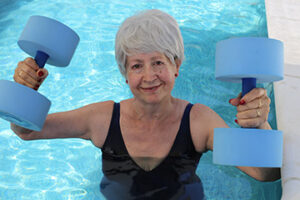Aquatic Therapy: A Proven Benefit for Stroke Recovery
Posted
Strokes affect nearly 800,000 people per year in the United States alone. Of those people, 50% suffer from long term muscle weakness and 85% suffer from proprioception impairments. The rehabilitation process after a stroke can be long and tedious; research supports the use of aquatic therapy in stroke rehabilitation with patients showing improvements in nearly all areas studied when compared to land-based therapy alone.
According to research conducted by Jitka Veldena at the University of Regensburg, “aquatic therapy is effective in supporting walking, balance, emotional status and health related quality of life, spasticity, and physiological indicators. In comparison with land-based interventions, aquatic therapy shows superior effectiveness on balance, walking, muscular strength, proprioception, health related quality of life, physiological indicators, and cardiorespiratory fitness in all participants of the study.”
The unique properties of water provide significant benefits to stroke patients:
- • The viscosity of water provides constant tactile and vestibular input that results in changes in the Neurocortex of the brain yielding higher cognitive functioning. Because the patient is experiencing higher cognitive functioning while in the water, safety and independence increase.
- • Warm water temperatures aide in relaxation. As the patient’s muscles relax, spasticity and joint contractures become less severe and range of motion increases.
- • The buoyancy of water allows the patient to safely complete activities in the water that they aren’t able to on land.
Aquatic therapy is especially beneficial for hemiparetic patients. With increased stimulation to the parasympathetic nervous system, muscle tone and spasms are reduced and relaxation and blood flow to the muscles increases. Reduced tone coupled with decreased weight bearing (from the buoyancy of water) results in many patients being able to work through full range of motion with the effected limb(s). Spatial and perceptual deficits are also targeted with aquatic therapy. Utilizing the buoyancy of water allows for increased reaction times with loss of balance, making it possible to safely focus on finding midline orientation (unlike in land treatments where fall risk is high). Finally, aquatic therapy is also beneficial when addressing cognitive impairments as well as physical impairments. Because cerebral blood flow increases with immersion, cognitive function improves.
Indications for Aquatic Therapy:
- Patient needs assistive device and/or heavy physical assist on land
- Limited single leg stance
- Severe pain
- Extreme weakness (strength is less than 3/5)
- Love of water
Benefits for Clinician:
- Avoid use of assistive device and/or heavy physical assist
- Decreased risk for fall and injury of patient and/or therapist
- Allows patients to experience movements they aren’t able to on land
If you treat patients recovering from stroke, consider adding aquatic therapy with Hudson’s custom therapy pools and underwater treadmills. Contact Us today to offer better, quicker patient outcomes and increase your bottom line.




